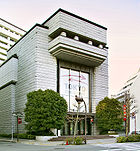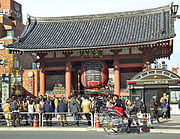Tokyo
From Wikipedia, the free encyclopedia.
 |
|
| Capital | Shinjuku |
| Region | Kanto |
| Island | Honshu |
| Governor | Shintaro Ishihara |
| Area | 2,187.08 km² (45th) |
| - % water | 1.0% |
| Population (October 1, 2003) | |
| - Population | 12,527,115 (8,444,531 in 23 wards) (1st) |
| - Density | 5655 /km² |
| Districts | 1 |
| Municipalities | 62 |
| ISO 3166-2 | JP-13 |
| Web site | www.metro.tokyo.jp/ ENGLISH/ |
| Prefectural Symbols | |
| - Flower | Somei-Yoshino cherry blossom |
| - Tree | Ginkgo tree (Ginkgo biloba) |
| - Bird | Black-headed Gull (Larus ridibundus) |
 Adopted in June 1989, Tokyo's official symbol has three arcs forming the letter T for Tokyo in the shape of a vivid green ginkgo leaf. It symbolizes Tokyo's future growth and prosperity, charm, and tranquility. |
|

Tokyo (東京, Tōkyō ▶(?); literally, "eastern capital") is de facto capital of Japan and home to the Japanese government and emperor. It is also the nation's most populous urban area (12 million people, or about 10 percent of the country's population, live in Tokyo) and one of 47 prefectures of Japan.
Contents |
Tokyo: the de facto city
Under Japanese law, Tokyo is designated as a "metropolis" (都 -to) rather than a city, and its administrative structure is similar to that of Japan's other prefectures (県 -ken). It consists of 23 special wards (区 -ku) which once comprised the city of Tokyo but are now self-governing municipalities, as well as 26 cities (市 -shi), 5 towns (町 -chō or machi), and 8 villages (村 -son or mura), each of which has a local government. The Tokyo Metropolitan Government is headed by a publicly-elected governor and metropolitan assembly, located in the ward of Shinjuku.
Location
Tokyo is located in the Kanto region on the island of Honshu. Its center is at 35°41' North, 139°46' East (35.68333, 139.7667) [1], but its borders extend to outlying islands in the Pacific Ocean, some as far as 1,000 km south of the mainland.
Influence
As the nation's center of politics, business, finance, education, mass media, and pop culture, Tokyo has Japan's highest concentration of corporate headquarters, financial institutions, universities and colleges, museums, theaters, and shopping and entertainment establishments. It boasts a highly-developed public transportation system with numerous train and subway lines.
This extreme concentration is both boon and bane, prompting an ongoing debate over moving the nation's capital to another region. There is also great fear of a catastrophic earthquake striking Tokyo, which may in effect cripple the entire nation. Nevertheless, Tokyo continues to draw people from across Japan and other countries; a substantial portion of the population is not native to the region, and Tokyo is still a place to meet people from all over the country and the world.
History
- Main article: History of Tokyo

Tokyo's rise to prominence can be largely attributed to two men: Tokugawa Ieyasu and Emperor Meiji. In 1603, after unifying the warring states of Japan, Shogun Tokugawa Ieyasu made Edo (now Tokyo) his base of operations. As a result, the city developed rapidly and grew to become one of the largest cities in the world with a population topping 1 million by the 18th century. It became the de facto capital of Japan even while the emperor resided in Kyoto, the imperial capital.
Since the city's early beginnings and even now, Edo/Tokyo has always had a large non-native population. Ieyasu himself was an outsider who brought many outsiders to help build the city and government. The sankin kotai system also required provincial warlords to periodically parade to Edo and keep a residence in the city along with key family members and samurai retainers. The term "Edokko" (child of Edo) was even coined (and still used today) to distinguish the natives from the non-natives.
After 250 years of the Tokugawa, the shogunate was overthrown by two southern prefectures (Chōshū and Satsuma) under the banner of restoring imperial rule. In 1869, the figurehead 17-year-old Emperor Meiji was moved to Edo, which was renamed "Tokyo". Tokyo was already the nation's political, economic, and cultural center, and the emperor's residence made it a de facto imperial capital as well with the former Edo Castle becoming the Imperial Palace.

Tokyo went on to suffer two major catastrophes and has remarkably recovered from both of them. One was the Great Kanto Earthquake in 1923, and the other was World War II. The firebombings in 1945 were almost as devastating as the atomic bombs of Hiroshima and Nagasaki combined. Large areas of the city were flattened. Today, hardly a trace of the war is evident to visitors to the city, but many people still carry its emotional scars.
After the war, Tokyo was rebuilt with excellent train and subway systems, which were showcased to the world during the city's 1964 Summer Olympics. The 1970s brought new high-rise developments, a new and controversial airport at Narita (1978), and a population increase to about 11 million (in the metropolitan area). In the 1980s, real estate prices skyrocketed during an economic bubble: many got rich quick, but the bubble burst in the early 1990s and many companies, banks, and individuals were caught with real estate shrinking in value. A major recession followed, making the 1990s Japan's "lost decade" which still continues today.
Tokyo still sees new or renewed urban centers being developed on large lots of idle land. Recent projects include Ebisu Garden Place, Tennozu Isle, Shiodome, Roppongi Hills, Shinagawa (now also a shinkansen station), and Tokyo Station (Marunouchi side). Land reclamation projects in Tokyo have also been going on for centuries. The most prominent is the Odaiba area, now a major shopping and entertainment center.
Geography and administrative divisions

Tokyo is northwest of Tokyo Bay, and is about 90 km east-to-west and 25 km north-to-south. It borders Chiba Prefecture to the east, Yamanashi Prefecture to the west, Kanagawa Prefecture to the south, and Saitama Prefecture to the north. It also consists of islands in the Pacific Ocean directly south -- the Izu Islands are closest, while the Ogasawara Islands stretch over 1,000 km away from mainland Japan.
Toyko has been hit by powerful earthquakes in 1703, 1782, 1812, 1855 and 1923. The 1923 earthquake with an estimated magnitude of 8.3 killed 142,000 people.
Tokyo is also part of the Greater Tokyo Area, by far the world's most populous metropolitan region, which includes the surrounding prefectures of Kanagawa, Saitama, and Chiba.
Tokyo consists of the following 23 special wards, 26 cities, 5 towns, and 8 villages:
23 special wards
Each ward (ku) is a local municipality with its own elected mayors and assemblies but differs from ordinary cities in that certain governmental functions are handled by the Tokyo Metropolitan Government.
As of September 1, 2003, the official total population of the 23 wards combined was about 8.34 million, with a population density of 13,416 persons per square kilometer.
Cities
West of the 23 wards, Tokyo consists of cities (shi), which enjoy a similar legal status to cities elsewhere in Japan. While serving a role as "bed towns" for those working in central Tokyo, some of these cities also have a local commercial and industrial base. Collectively, these cities are often known as "West Tokyo."
Districts, towns, and villages
The far west is occupied by the district (gun) of Nishitama. Much of this area is mountainous and unsuitable for urbanization. The highest mountain in Tokyo, Mount Kumotori, is 2,017 m high; other mountains in Tokyo include Mount Takasu (1737 m), Mount Odake (1266 m), and Mount Mitake (929 m). Lake Okutama, on the Tama River near Yamanashi Prefecture, is Tokyo's largest lake.
Islands
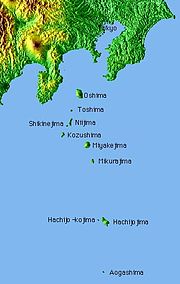
Tokyo's outlying islands extend as far as 1,850 km from central Tokyo. Because of the islands' distance from the city, they are locally run by branches of the metropolitan government. Most of the islands are classified as villages.
- Oshima—Islands of Kozushima, Niijima, Oshima, and Toshima.
- Miyake—Islands of Mikurajima and Miyakejima (main town: Miyake).
- Hachijo—Islands of Aogashima and Hachijojima (main town: Hachijo).
- Ogasawara—Ogasawara includes, from north to south, Chichi-jima, Nishinoshima, Haha-jima, Kita Iwo Jima, Iwo Jima, and Minami Iwo Jima. Also includes two tiny outlying islands: Minami Torishima, the easternmost point in Japan and at 1 850 km the most distant island from central Tokyo, and Okino Torishima, the southernmost point in Japan. The Iwo chain and the outlying islands are mostly uninhabited, but there are small local populations on the three islands closer to Honshu.
National Parks
There are two national parks in West Tokyo: Chichibu-Tama National Park, located in Nishitama and spilling over into Yamanashi and Saitama Prefectures, and Meiji no Mori Takao Quasi-National Park, located around Mount Takao to the south of Hachioji.
South of Tokyo is the Ogasawara National Park.
Major Districts



The center of Tokyo is Kokyo, or the Imperial Palace, the former site of Edo Castle. The term "central Tokyo" today may refer to either the area within the looping Yamanote train line or to Tokyo's 23 special wards (ku) covering about 621 square kilometers, the most densely-populated area of Tokyo.
There are a number of major urban centers where business, shopping, and entertainment are concentrated. They all center around a major train station where multiple train lines operate.
- Shinjuku — Tokyo's capital where the Tokyo Metropolitan Government Building is located. It is best known for Tokyo's early skyscrapers since the early 1970s. Major department stores, camera and computer stores, and hotels can be found. On the east side of Shinjuku Station, Kabuki-cho is notorious for its many bars and nightclubs.
- Marunouchi and Otemachi — The main financial and business district of Tokyo has many headquarters of banks, trading companies, and other major businesses. The area is seeing a major redevelopment with new buildings for shopping and entertainment constructed in front of Tokyo Station's Marunouchi side.
- Ginza and Yurakucho — Major shopping and entertainment district with department stores, upscale shops selling brand-name goods, and movie theaters.
- Shinbashi—By being the gateway to Odaiba and having the new Shiodome Shiosite complex of high-rise buildings, this area has been effectively revitalized.
- Shinagawa — In addition to the major hotels on the west side of Shinagawa Station, the former sleepy east side of the station has been redeveloped as a major center for business.
- Shibuya — A longtime center of shopping, fashion, and entertainment, especially for the younger set.
- Ikebukuro — Anchored by the Sunshine City (which was once Tokyo's tallest building) hotel and shopping complex, this is another area where people gather due to the various train lines shooting out of Ikebukuro Station.
- Ueno — Ueno Station serves areas north of Tokyo from where many people commute. Besides department stores and shops in Ameyoko, Ueno boasts Ueno Park, Ueno Zoo, and major national museums. In spring, Ueno Park and adjacent Shinobazu Pond are prime places to view cherry blossoms.
- Odaiba — A large, reclaimed, waterfront area that has become one of Tokyo's most popular shopping and entertainment districts.
- Kinshicho — Major shopping and entertainment area in eastern Tokyo.
- Kichijoji — Major shopping and entertainment area in western Tokyo.
- Nagatacho - The political heart of Tokyo and the nation. It is the location of the Diet, government ministries, and party headquarters.
- Aoyama - An upscale neighborhood of Tokyo with parks, an enormous cemetery, expensive housing, trendy cafes, and international restaurants (includes the subway station Omotesando).
Economy
Tokyo has the largest metropolitan economy in the world: its nominal GDP of around $1.315 trillion is greater than that of South Korea and Mexico. It is a major international finance center, headquarters to several of the world's largest investment banks and insurance companies, and serves as a hub for Japan's transportation, publishing, and broadcasting industries.
During the centralized growth of Japan's economy following World War II, many large firms moved their headquarters from cities such as Osaka (the historical commercial capital) to Tokyo, in an attempt to take advantage of better access to the government. This trend has begun to slow due to ongoing population growth in Tokyo and the high cost of living there.
Demographics
As one of the major cities of the world, Tokyo has over 8 million people living within its 23 wards, and during the daytime, the population swells by over 2.5 million as workers and students commute from adjacent areas. This effect is even more pronounced in the three central wards of Chiyoda, Chuo, and Minato, whose collective population is less than 300,000 at night, but over 2 million during the day.
Population
By area (as of Oct. 1, 2003)
- All of Tokyo: 12.36 million
- 23 special wards: 8.34 million
- Tama area: 4 million
- Islands: 27,000
By age (As of Jan. 1, 2003):
- Juveniles (0-14): 1.433 million (12%)
- Working population (15-64): 8.507 million (71.4%)
- Aged population (65+): 2.057 million (16.6%)
By time (As of 2000)
- Nighttime: 12.017 million
- Daytime: 14.667 million
By nationality
- Foreign residents: 353,826 (as of Jan. 1, 2005)
- Top 5 Nationalities of Foreign Residents: Chinese (120,331), Korean (103,191), Philippine (31,505), American (18, 043), British (7,585)
Transportation
Tokyo is Japan's largest domestic and international hub for rail, ground, and air transportation. Public transportation within Tokyo is dominated by an extensive network of clean and efficient, if occasionally very crowded trains and subways run by a variety of operators, with buses, monorails and trams playing a secondary role.
Airports
- Tokyo International Airport in Ota Ward (Haneda) — Mainly for domestic flights.
- Narita International Airport in Narita, Chiba Prefecture — Major gateway for international travelers.
- Chofu Airport in Chofu City — Handles commuter flights to the Izu islands.
- Oshima Airport— Oshima Island
- Hachijojima Airport— Hachijo Island
- Miyakejima Airport— Miyake Island
- Tokyo Heliport— Koto Ward
Railways and subways

Rail is the primary mode of transportation in Tokyo, which has the most extensive underground network in the world and an equally extensive network of surface lines. Most lines in Tokyo are privately owned and operated, with the exception of Toei Subway (run directly by the metropolitan government). Railway and subway lines are highly integrated; commuter trains from the suburbs continue directly into the subway network on many lines, often emerging on the other side of the city to serve another company's surface line. It is estimated some 20 million people take the 70 plus train lines and go through 1000 stations in the metropolitan area daily. Some of the larger stations, like Shinjuku Station and Tokyo station, are miles long and are the busiest in the world.

- JR East—The largest passenger railway company in the world. In addition to the Shinkansen ("bullet train" lines), JR operates Tokyo's largest railway network, including the Yamanote Line loop, the Keihin-Tohoku Line between Saitama and Yokohama, the Chuo Line to West Tokyo, and the Sobu Line to Chiba. It is also the majority stockholder in the Tokyo Monorail, one of the world's most commercially successful monorail lines.
- Keihin Kyuko Electric Railway (Keikyū)—Operates out of Shinagawa Station to Kanagawa and Haneda Airport.
- Keisei Electric Railway—Operates out of Ueno Station to Chiba (including Narita International Airport).
- Keio Electric Railway—Operates out of Shinjuku Station to West Tokyo.
- Odakyu Electric Railway—Operates out of Shinjuku Station to Kanagawa, most notably Odawara and Hakone.
- Seibu Railway—Operates out of Shinjuku Station and Ikebukuro Station to West Tokyo.
- Tobu Railway—Operates out of Ikebukuro Station and Asakusa Station to Saitama, Gunma, and Tochigi.
- Tokyo Kyuko Electric Railway (Tokyu)—Operates out of Shibuya Station to West Tokyo and Kanagawa.
- Tokyo Metro (formerly Eidan)—Operates Japan's largest subway network.
- Tokyo Metropolitan Bureau of Transportation—Operates the Toei subway lines and the Arakawa streetcar line, Tokyo's sole streetcar line.
- Tsukuba Express, linking Akihabara Station with Tsukuba since its opening in August 2005.
Buses
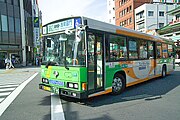
The metropolitan government operates Toei buses mainly within the 23 special wards while private bus companies operate other bus routes. Bus transportation is convenient for places far from the train or subway stations. Most bus routes stop or terminate at a train or subway station, and they can be quite complicated with no signs in English. The Toei buses charge 200 yen per ride which the customer pays while boarding. Buses run by other companies may charge according to distance, and the customer pays when leaving the bus.
Others
- Taxis—Available along most major streets. Starting fare is about 650 yen.
- Streetcars—Once a common sight before subways and buses came to fore, streetcar lines have shrunk to only one route called the Toden Arakawa Line plying the route between Waseda and Minowabashi.
- Ferries/Boats—Long-distance ferries operated by Tokai Kisen go to outlying islands such as the Ogasawara Islands and Izu Islands. River boats on the Sumida River operate between Asakusa and Kasai Rinkai Park, mainly for tourists.
- Expressways—Many expressways converge at Tokyo including the Tomei Expressway, Chuo Expressway, Kan'etsu National Expressway, Ken-ō Expressway, Tokyo Gaikan Expressway, Daisan Keihin Highway, and Keiyo Highway. The Shuto Expressway network covers central Tokyo, linking the intercity expressways together.
Tourism
Tokyo has many tourist attractions. It would take weeks to see all the major ones. Thanks to a very convenient train and subway system (with signs in English), it is easy to visit most of these attractions. Here are only some of them (random order).
Shrines, temples, and castles
The Imperial Palace, Meiji Shrine, and Sensoji Temple are the three most popular ones in Tokyo.
- Kokyo, or the Imperial Palace — Home of the Emperor and Crown Prince and their families.
- Sensoji — Asakusa
- Meiji Shrine — Dedicated to Emperor Meiji
- State Guest-House
- Yasukuni Shrine
- Zojoji — Main headquarters of the Pure Land Buddhism (浄土宗)sect.
- Tsukiji Honganji Temple — Tokyo headquarters of the Jodo Shinshu Nishi Honganji Buddhist sect.
- Gokokuji Temple
Festivals and events
Tokyo holds many festivals large and small throughout the year.
Spring (March-May)
- Bunkyo Tsutsuji Matsuri (azalea festival) at Nezu Shrine in Bunkyo-ku.
- Fuji Matsuri (wisteria festival) at Kameido Tenjin Shrine in Koto-ku.
- Hinode Matsuri (sunrise festival) at Mitake Shrine in Ome.
- Kachiya Festival at Katori Shrine in Koto-ku.
- Kanda Myojin Omikoshi Togyo at Kanda Myojin Shrine in Chiyoda-ku.
- Kappa Matsuri at Ebara Shrine in Shinagawa-ku.
- Kifune Matsuri at Kifune Shrine in Ota-ku.
- Kurayami Matsuri (black night festival) at Okunitama Shrine in Fuchu.
- Meiji Shrine Spring Festival at Meiji Shrine in Shibuya-ku.
- Osunafumi Taisai (walking-on-sand ritual) at Tamagawa Daishi Temple in Setagaya-ku.
- Sanja Matsuri at Asakusa Shrine in Taito-ku.
- Shishi Matsuri (lion dance festival) at Nagasaki Shrine in Toshima-ku.
- Takigi Noh (open-air torchlight Noh performance) at Zojoji Temple in Minato-ku.
- Yayoi Matsuri ceremony by the Edo Shobo Kinen-kai (Edo Civilian Fire Fighters' Association) in the vicinity of Sensoji Temple in Taito-ku.
Summer (June-Aug.)
- Koenji Awa Odori
- Asakusa Samba Matsuri
- Sumida Fireworks in Asakusa and Sumida Ward
- Tokyo Bay Fireworks
- Jingu Fireworks
- Fukagawa Hachiman Matsuri
Fall (Sept.-Nov.)
- Tokyo Jidai Matsuri in Asakusa
Winter (Dec.-Feb.)
- Hatsumode New Year's Prayers at Meiji Shrine, Sensoji, and other major shrines and temples
- Dezome-shiki Fireman's Parade at Tokyo Big Sight
- Setsubun at Sensoji and other major temples
Others
- Grand Sumo Tournaments in Jan., May, and Sept. at the Ryogoku Kokugikan
- Tsukiji fish market
Parks and gardens
Flowers

- Plum blossoms (Feb.-March)—Yoshino Baigo in Ome, Mukojima Hyakkaen Garden, Hanegi Park in Umegaoka
- Cherry blossoms (Late March-early April)—Ueno Park and Shinobazu Pond, Yoyogi Park, Shinjuku Gyoen, Inokashira Park in Kichijoji, Chidorigafuchi Imperial Palace moat near the Budokan, Aoyama Cemetery, Sumida Park and River near Asakusa, International Christian University
- Wisteria (Late April-early May)—Kameido Tenjin Shrine in Koto Ward
- Azaleas (Late April-early May)—Nezu Shrine, East Garden of the Imperial Palace, Shiofune Kannon Temple in Ome
- Roses (mid-late May)—Jindai Botanical Garden in Chofu
- Irises (early-mid June)—Meiji Shrine, Horikiri Iris Garden
- Hydrangeas (June-July)—Takahata Fudo Temple, Hino
Scenic views
- Tokyo Tower
- Tokyo Metropolitan Government Building Observatory
- Rainbow Bridge walkway
- Sunshine City Observatory in Ikebukuro
- Fuji TV Headquarters Observatory in Odaiba
Shopping and entertainment


Tokyo has various shopping districts famous for specific products. Akihabara is well-known for electronics stores, Shinjuku for camera and book shops, Ginza for department stores and luxury goods, Shibuya and Harajuku for teenage fashion, and Jimbocho for used (and new) books.
|
|
- See also: Tourism in Japan
Prefectural symbols
The Tokyo Metropolitan Government uses a gingko leaf design in iron fences along streets, Toei metropolitan buses, and other facilities they own or operate.
Traditional symbols of Tokyo include Nijubashi (a bridge at the Imperial Palace), the National Diet Building, the Kaminarimon (Thunder Gate) housing the big red paper lantern at Sensoji in Asakusa, the State Guest-House in the Akasaka Imperial Palace, and the Meiji-era facade of Tokyo Station. More contemporary symbols include the skyscrapers of Shinjuku, the neon signs at night in Ginza, Tokyo Tower, the Rainbow Bridge, and the Mori Tower at Roppongi Hills, among many others.
Culture
Museums
Tokyo has numerous museums and art galleries. This list is by no means exhaustive.
- Tokyo National Museum
- National Museum of Western Art
- Edo-Tokyo Museum
- Tokyo Metropolitan Teien Art Museum
- Edo-Tokyo Open Air Architectural Museum
- Museum of Contemporary Art Tokyo in Kiba
- Tokyo Metropolitan Art Museum
- Tokyo Metropolitan Museum of Photography in Ebisu Garden Place
- Tokyo Metropolitan Art Space
- Tokyo Bunka Kaikan
- Kokugikan Sumo Museum
- Fukagawa-Edo Museum in Koto Ward
- Japanese Sword Museum
- Tokyo Opera City
- Mori Art Museum in Roppongi Hills
Theaters

- Kabuki-za
- National Noh Theater (Kokuritsu Nohgaku-do)
- National Theatre (Kokuritsu Gekijo)
Modern architecture
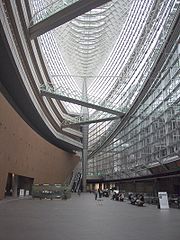
- Tokyo Tower
- Rainbow Bridge
- National Diet Building
- Yoyogi Olympic Pool
- Tokyo Metropolitan Government Building
- Tokyo Big Sight
- Tokyo Station red brick building
- Tokyo International Forum
Fashion
- Omotesando—Fashion capital of Japan.
- Harajuku—Street fashion capital of Japan.
- Shibuya—Teen fashion capital of Japan.
Tokyo in popular media
As the largest city in Japan and the location of the country's largest broadcasters and studios, Tokyo is frequently the setting for many Japanese movies, television shows, animated series (anime), and comic books (manga). The most well-known outside Japan may be the kaiju (monster movie) genre, in which landmarks of Tokyo are routinely destroyed. Many comic books and animated series set in Tokyo, such as Sailor Moon, Ranma 1/2, and Yu-Gi-Oh!, have become popular across the world as well.
Some Hollywood directors have turned to Tokyo as a filming location. Well-known examples from the postwar era include Tokyo Joe, My Geisha, and the James Bond film You Only Live Twice; well-known contemporary examples include Kill Bill and Lost in Translation.
For a more complete list, see: List of movies, manga, anime, and television shows that take place in Tokyo
Education
Being the nation's center of education, Tokyo boasts many universities, junior colleges, and vocational schools. Many of Japan's most prestigious universities are in Tokyo. The most prestigious is the University of Tokyo. Other schools include Keio University, Hitotsubashi University, and Waseda University.
Tokyo also has a few universities well-known for classes instructed in English. They include International Christian University, Sophia University, and Temple University Japan.
Universities in Tokyo
National Universities
- Ochanomizu University
- University of Electro-Communications
- Tokyo Medical and Dental University
- Tokyo University of Foreign Studies
- Tokyo Gakugei University
- Tokyo University of Marine Science and Technology
- Tokyo Geijutsu Daigaku
- Tokyo Institute of Technology
- University of Tokyo
- Tokyo University of Agriculture and Technology
- Hitotsubashi University
Public University
Private Universities
Public schools
The kindergartens, elementary schools (years 1 through 6), and junior high schools (7 through 9) are operated by local wards or municipal offices. Public high schools in Tokyo are run by the Tokyo Metropolitan Government Board of Education and are called "Metropolitan High Schools". [2]. For a list of high schools in Japanese, see [3].
Private schools
In addition to public schools, Tokyo has many private schools.
Private secondary schools include:
- Azabu High School (Grades 7 through 12)
- Musashi Junior & Senior High School (Grades 7 through 12)
Professional sports
Tokyo is home to two professional baseball clubs, the Yakult Swallows (Meiji Jingu Stadium) and Yomiuri Giants (Tokyo Dome).
The Japan Sumo Association is also headquartered in Tokyo at the Ryogoku Kokugikan sumo arena where three official sumo tournaments are held annually (in January, May, and September).
Football (soccer) clubs in Tokyo include FC Tokyo and Tokyo Verdy 1969, both of which play at Ajinomoto Stadium in Chofu.
With a number of world-class sports venues, Tokyo often hosts national and international sporting events such as tennis tournaments, swim meets, marathons, American football exhibition games, judo, karate, etc.
Miscellaneous topics
Sister cities
- Beijing, People's Republic of China
- Berlin, Germany
- Cairo, Egypt
- Jakarta, Indonesia
- Moscow, Russia
- New York City, New York, United States
- Paris, France
- Rome, Italy
- São Paulo, Brazil
- Seoul, South Korea
- Sydney, Australia
In addition, many of the wards and cities within Tokyo maintain sister-city relationships with other foreign cities
| North: Saitama | ||
| West: Kofu | Tokyo, International Airport | East: Chiba, Narita, International Airport |
| South: Yokohama, Kawasaki |
External links
Travel guide to Tokyo from Wikitravel
- Festivals around Tokyo The Japan Times
- Interactive satellite view of the area
- Japan-guide to Tokyo
- Official Tokyo Metropolitan Government homepage
- Tokyo Diary Tokyo business/professional events calendar
- Tokyo Metro Subway lines
- Tokyo Past and Present Web Japan
References
|
|||
| Wards | |||
|---|---|---|---|
| Adachi | Arakawa | Bunkyō | Chiyoda | Chūō | Edogawa | Itabashi | Katsushika | Kita | Kōtō | Meguro | Minato | Nakano | Nerima | Ōta | Setagaya | Shibuya | Shinagawa | Shinjuku (capital) | Suginami | Sumida | Toshima | Taitō | |||
| Cities | |||
| Akiruno | Akishima | Chōfu | Fuchū | Fussa | Hachiōji | Hamura | Higashikurume | Higashimurayama | Higashiyamato | Hino | Inagi | Kiyose | Kodaira | Koganei | Kokubunji | Komae | Kunitachi | Machida | Mitaka | Musashimurayama | Musashino | Nishi-Tōkyō | Ōme | Tachikawa | Tama | |||
| Districts and Subprefectures | |||
| Nishitama District | Hachijō Subprefecture | Miyake Subprefecture | Ogasawara Subprefecture | Ōshima Subprefecture | |||
| edit |
| edit | Prefectures of Japan | |
|---|---|---|
| Aichi | Akita | Aomori | Chiba | Ehime | Fukui | Fukuoka | Fukushima | Gifu | Gunma | Hiroshima | Hokkaido | Hyogo | Ibaraki | Ishikawa | Iwate | Kagawa | Kagoshima | Kanagawa | Kochi | Kumamoto | Kyoto | Mie | Miyagi | Miyazaki | Nagano | Nagasaki | Nara | Niigata | Oita | Okayama | Okinawa | Osaka | Saga | Saitama | Shiga | Shimane | Shizuoka | Tochigi | Tokushima | Tokyo | Tottori | Toyama | Wakayama | Yamagata | Yamaguchi | Yamanashi | ||
| Regions of Japan | ||
| Hokkaido | Tohoku | Kantō | Chubu (Hokuriku - Koshinetsu - Tokai) | Kansai | Chugoku | Shikoku | Kyushu | ||
| Major Cities (Cities designated by government ordinance) | ||
| 23 wards of Tokyo | Chiba | Fukuoka | Hiroshima | Kawasaki | Kitakyushu | Kobe | Kyoto | Nagoya | Osaka | Saitama | Sapporo | Sendai | Shizuoka | Yokohama | ||

